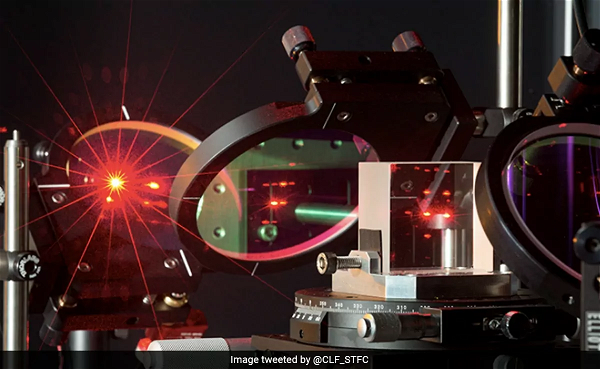Blog Credit : Trupti Thakur
Image Courtesy : Google
Vulcan 20-20
The UK is undertaking a groundbreaking project to create the world’s most powerful laser, called “Vulcan 20-20,” with an £85 million investment from the UK Science and Technology Facilities Council. This laser, anticipated to be a million billion times brighter than the sun, is expected to have profound implications for various scientific fields, including clean energy and cancer treatment.
Vulcan 20-20: A Revolution in Laser Technology
The “Vulcan 20-20” is currently underway at the Science and Technology Facilities Council’s Central Laser Facility (CLF) in Oxfordshire. This endeavor promises far-reaching implications, with the potential to revolutionize scientific exploration across various domains, including clean energy and advancements in cancer treatment.
Unprecedented Capabilities
- The name “Vulcan 20-20” reflects its extraordinary capabilities.
- This laser will generate a primary beam with a staggering energy output of 20 Petawatts (PW), accompanied by eight high-energy beams with outputs of up to 20 Kilojoules (KJ).
- This remarkable enhancement represents a twentyfold increase in power, positioning the Vulcan 20-20 at the pinnacle of laser supremacy.
- Remarkably, a single pulse from this laser will deliver more power than the entire National Grid, according to UK Research and Innovation, the project’s sponsor.
Surpassing the Sun and Economic Implications
The current flagship laser within CLF, the Vulcan laser, renowned for its versatility in plasma physics, will be dwarfed by the Vulcan 20-20’s capabilities. This new laser will shine a light a hundred times brighter than even the most intense sunlight witnessed in the Sahara Desert.
Its significance spans across various scientific fields, including clean energy sources. It is expected to create numerous skilled jobs in science and engineering, contributing to the UK’s science sector and overall economic growth.
Summary
This ambitious £82M upgrade project will last six years. The name ‘Vulcan 20-20’ was born from the exciting technical specifications of the new laser – the facility will house a single 20 Petawatt beam together with additional laser beams (up to 8 beams) with a total energy output of up to 20 Kilojoules.
Vulcan 20-20 will be able to study a range of subjects in brand new detail, for example:
- Learning about astrophysical phenomena by using lasers as tools to replicate interstellar conditions.
- Aiding in research towards a potential new frontier for clean energy, laser fusion.
- Expand the possibilities of plasma physics and its technological applications.
- The ground-breaking power of Vulcan 20-20 may mean we will be able to conduct physics experiments that step into brand new unknowns and explore beyond the present Standard Model.
With the significant expansion of the CLF’s flagship laser facility, we are creating new roles to fill in science and engineering. The project will require a wide range of expertise from for post-docs, PhDs, graduate trainees to technician and apprentices. Find details of the current posts available here!
Further Details
The Vulcan 20-20 project will increase the peak power of the Vulcan laser by 20 times, taking it from 1PW (500J in 500fs) to 20PW (400J in 20fs).Additionally, we will increase the long pulse energy we can deliver. This will be achieved by upgrading our traditional six long pulse beams to give 10KJ and enabling the delivery of the other high energy beams, used as pump sources, to give up to 20KJ of energy. We will retain the existing 100TW (100J in 1ps) capability and the VOPPEL beamline (30J in 30fs) to offer the scientific community access to a unique combination of beamlines to study matter under extreme conditions. The footprint of the existing facility will be extended to the south and the west.
The upgraded facility will offer two large experimental areas located on the ground floor. The current Target Area West will have its walls thickened and it will be enlarged to the south and west. Target Area Petawatt will have the same footprint, but the current PW capability will be removed. Both experimental areas will have new interaction chambers capable of fielding a new suite of plasma diagnostics. Located between the two experimental areas will be a new compressor area which will be used to compress the 20PW pulses that are generated on the second floor.
The second floor of the extension will house the laser generation and amplification areas for the 20PW and VOPPEL beamlines. Both the 20PW and VOPPEL beamlines will be based on the technique of Optical Parametric Chirped Amplification which uses three-wave-mixing in non-linear crystals to convert energy from an energetic pump beam to increase the energy of a seed beam. The pump lasers for the beamlines will be on this floor too, there will be 2 x 2KJ beams needed to generate the 20PW pump laser and we are developing the technology to enable these pump lasers to be fired more rapidly.
For the long pulse upgrade of our traditional six-long pulse beams, we will need to reconfigure the current laser beam arrangements in the ground floor laser areas. We will convert them into a multi-pass arrangement, meaning that the pulses being amplified will pass through the same amplifier four times so that we can efficiently extract the energy that they contain. Each of the upgraded beams will be capable of generating ~1.6KJ and will be frequency doubled to the second harmonic before delivery to the experimental areas. To provide the energy for the new amplifiers the long pulse upgrade and the 20PW beamline we will need an additional capacitor bank that will be used to store electrical energy before it is released into the flash lamps where it is converted to light and absorbed by the glass in the amplifiers.
Blog By: Trupti Thakur

04
OctVulcan 20-20
Oct 04, 2023Recent Blog
India’s Steps Into 6GMay 15, 2025
The New Accessibility Feature of AppleMay 14, 2025
The Digital Threat Report 2024May 13, 2025
The MADMAX ExperimentMay 12, 2025
The EntraID Data ProtectionMay 10, 2025




